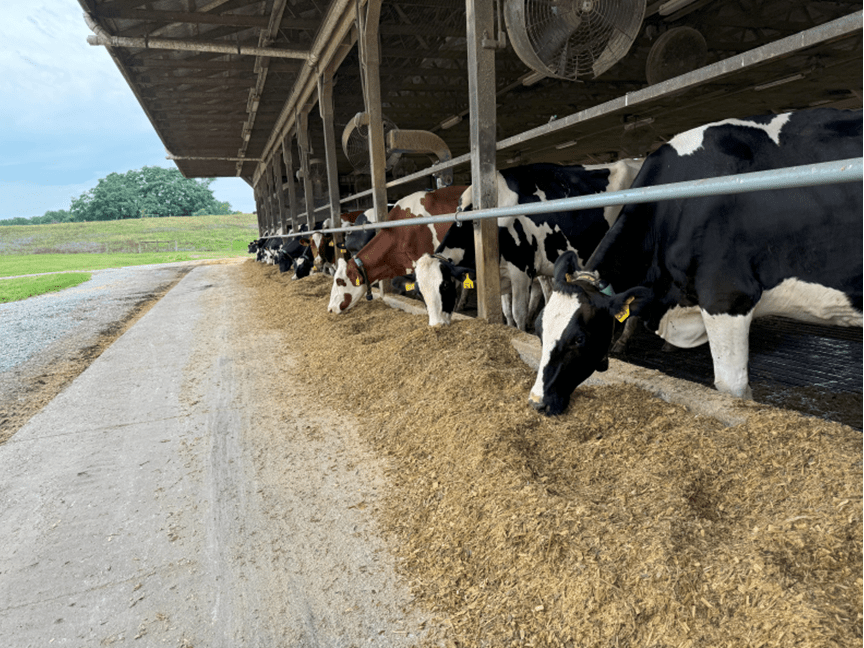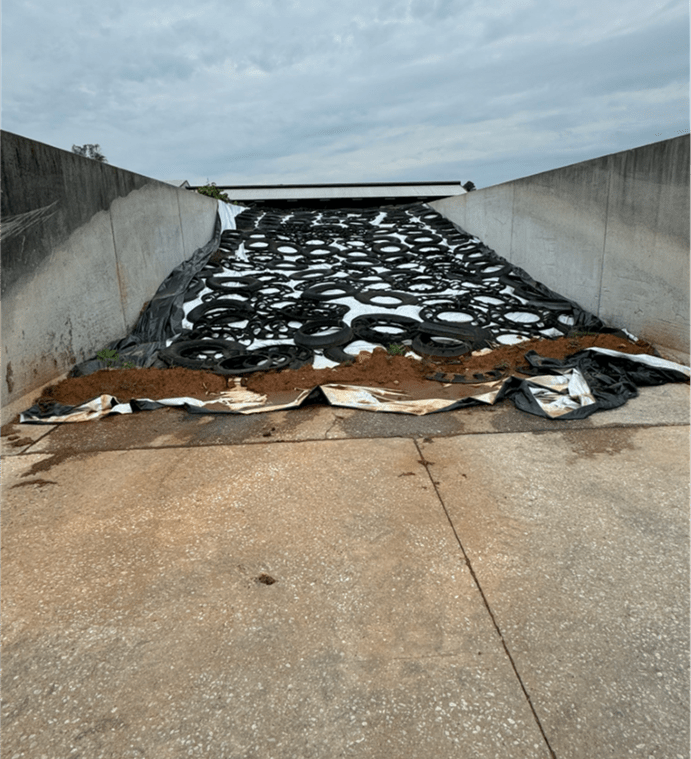Ensiling Management for Corn Silage
Niraj Suresh and Fabiana Cardoso Animal & Avian Sciences, University of Maryland

In Maryland, corn used for livestock feed will normally begin to be harvested in late September and in to October. After this dairy farmers planning to use corn for whole plant corn silage will begin ensiling the chopped corn (green chop) to allow it to ferment and eventually become corn silage. Ensiling corn is an intricate process that must be done correctly or else the farmer risks suboptimal or even spoiled feed which can have catastrophic consequences for a dairy operation. In this article we will share some tips to ensure that your corn can be ensiled correctly and ferment to make great feed.
Preparation:
- Have a well thought out plan beforehand: Ensiling must be done quickly for the best results, have everything ready to go before you begin. Know exactly what you want to do and make sure everyone is on the same page. Make sure to plan according to the weather as well.
- Have the right equipment: Due to the impact it will have on your feed and performance, ensiling is one of the most important processes on the farm. Make sure you have the best equipment possible and consider renting. Having the best silage, you can should be a top priority. For example, if you don’t have the best tractors for packing, consider renting a really good tractor from another farmer.
- Make sure the silo is clean: Remove all old feed and debris from the silo before you start packing it. This will allow for you to have the best possible feed and avoid contamination from microorganisms and mycotoxins.
Ensiling:
- If you are using a bunker silo, line the wall with plastic to limit oxygen penetration.
- When using a tractor to pack, go over the corn multiple times to make it as even as possible.
- Slope the silage down 1 to 2% away from the feedout face to encourage drainage from the face of the feedout area.
- Cover the feed as soon as possible when done packing. It should be done no later than 24 hours and preferably right after the feed is packed.
- Make sure to have adequate weight over the plastic cover, tires and sandbags are most commonly used with gravel or soil at the end on the ground.
- Use a tarp to protect the cover from weather and vermin.
- If using a tower silo, a forage distributor can be used to have a more even compaction throughout the silo.
- When overlapping sheets, make sure there is at least 4 feet of overlap in between sheets to ensure proper sealing.
- When walking on the plastic sheets, wear shoes that are less likely to tear it.
Having good silage is an essential for the vast majority of Maryland dairy farmers. A good farmer will make ensiling a top priority. For some farmers, it is only one day in the entire year. That one day can make or break their operation. Taking the proper steps when ensiling corn will ensure the corn has a proper fermentation process.
 English
English العربية
العربية Български
Български 简体中文
简体中文 繁體中文
繁體中文 Hrvatski
Hrvatski Čeština
Čeština Dansk
Dansk Nederlands
Nederlands Suomi
Suomi Français
Français Deutsch
Deutsch Ελληνικά
Ελληνικά हिन्दी
हिन्दी Italiano
Italiano 日本語
日本語 한국어
한국어 Norsk bokmål
Norsk bokmål Polski
Polski Português
Português Română
Română Русский
Русский Español
Español Svenska
Svenska Català
Català Filipino
Filipino עִבְרִית
עִבְרִית Bahasa Indonesia
Bahasa Indonesia Latviešu valoda
Latviešu valoda Lietuvių kalba
Lietuvių kalba Српски језик
Српски језик Slovenčina
Slovenčina Slovenščina
Slovenščina Українська
Українська Tiếng Việt
Tiếng Việt Shqip
Shqip Eesti
Eesti Galego
Galego Magyar
Magyar Maltese
Maltese ไทย
ไทย Türkçe
Türkçe فارسی
فارسی Afrikaans
Afrikaans Bahasa Melayu
Bahasa Melayu Kiswahili
Kiswahili Gaeilge
Gaeilge Cymraeg
Cymraeg Беларуская мова
Беларуская мова Íslenska
Íslenska Македонски јазик
Македонски јазик יידיש
יידיש Հայերեն
Հայերեն Azərbaycan dili
Azərbaycan dili Euskara
Euskara ქართული
ქართული Kreyol ayisyen
Kreyol ayisyen اردو
اردو বাংলা
বাংলা Bosanski
Bosanski Cebuano
Cebuano Esperanto
Esperanto ગુજરાતી
ગુજરાતી Harshen Hausa
Harshen Hausa Hmong
Hmong Igbo
Igbo Basa Jawa
Basa Jawa ಕನ್ನಡ
ಕನ್ನಡ ភាសាខ្មែរ
ភាសាខ្មែរ ພາສາລາວ
ພາສາລາວ Latin
Latin Te Reo Māori
Te Reo Māori मराठी
मराठी Монгол
Монгол नेपाली
नेपाली ਪੰਜਾਬੀ
ਪੰਜਾਬੀ Afsoomaali
Afsoomaali தமிழ்
தமிழ் తెలుగు
తెలుగు Yorùbá
Yorùbá Zulu
Zulu ဗမာစာ
ဗမာစာ Chichewa
Chichewa Қазақ тілі
Қазақ тілі Malagasy
Malagasy മലയാളം
മലയാളം සිංහල
සිංහල Sesotho
Sesotho Basa Sunda
Basa Sunda Тоҷикӣ
Тоҷикӣ O‘zbekcha
O‘zbekcha አማርኛ
አማርኛ Corsu
Corsu Ōlelo Hawaiʻi
Ōlelo Hawaiʻi كوردی
كوردی Кыргызча
Кыргызча Lëtzebuergesch
Lëtzebuergesch پښتو
پښتو Samoan
Samoan Gàidhlig
Gàidhlig Shona
Shona سنڌي
سنڌي Frysk
Frysk isiXhosa
isiXhosa

